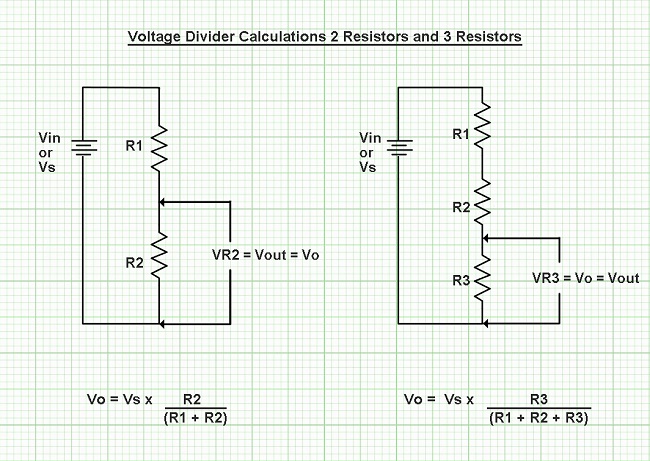Online Voltage Divider Calculator- 3 Resistors & 2 Resistors
This is an online voltage divider calculator 3 resistor and 2 resistor that can make the task of calculations much simpler. In this article, we’ll discuss voltage divider calculators and how to use them.
Voltage divider circuits are a fundamental part of the electronics and electrical engineering field. It is used to divide a given input voltage signal into the required level of voltage, means making it appropriate for different applications within the circuit. A voltage divider circuit consists of two or more resistors connected in series, with a given input voltage applied across these series resistor networks. And the output voltage is taken across one of the resistors. The output voltage is proportional to the value of the resistor across which it is measured.
Voltage Divider Calculator

Explanation:
The voltage divider is a simple circuit that is used in a variety of applications. It is commonly used to create reference voltages or to reduce the voltage of a power supply to a level that is suitable for an electronic circuit. The voltage across R2 can be calculated using the following formula:
Vout = Vs x (R2 / (R1 + R2))
where,
- Vs = Vin = is the applied source voltage or input voltage, SI unit is volts (V)
- R1 = is the resistance of 1st resistance, SI unit is (Ω)
- R2 = is the resistance of 2nd resistance, SI unit is (Ω)
- Vout = is the output voltage or voltage across R2, SI unit is volts (V)
The circuit consists of two resistors, R1 and R2, connected in series across a voltage source or lets say input voltage, Vs = Vin. The output voltage is taken across resistor R2. This formula is known as the voltage divider formula. It shows that the output voltage is directly proportional to R2 and inversely proportional to the sum of R1 and R2.
Check How to Calculate Voltage Drop across a Resistor , also check, derivation of Voltage Divider Rule and formula
Voltage Divider Calculator 3 Resistor
Explanation:
The voltage across R3 can be calculated using the following formula:
Vout = Vs x (R3 / (R1 + R2 + R3))
where,
- Vs = Vin = is the applied source voltage or input voltage, SI unit is volts (V)
- R1 = is the resistance of 1st resistance, SI unit is (Ω)
- R2 = is the resistance of 2nd resistance, SI unit is (Ω)
- R3 = is the resistance of 3st resistance, SI unit is (Ω)
- Vout = is the output voltage or voltage across R3, SI unit is volts (V)
The circuit consists of three resistors, R1, R2 and R3, connected in series across a voltage source or lets say input voltage, Vs = Vin. The output voltage is taken across resistor R3.
This formula is known as the voltage divider formula. It shows that the output voltage is directly proportional to R3 and inversely proportional to the sum of R1, R2 and R3. You can calculate voltage drop for each of the resistor in series value HERE!
How to use a voltage divider calculator?
Simply input the values of the resistors and the input voltage or source voltage. Once the inputs are entered, the calculator will compute the output voltage and display the result.
Benefits of Using this tool.
Using a voltage divider calculator offers several benefits. Firstly, it saves time and effort in calculating the output voltage of a voltage divider circuit. The calculator does all the calculations automatically, which eliminates the need for manual calculations. This is particularly useful when designing complex circuits that require multiple voltage divider circuits.
Secondly, using a voltage divider calculator improves the accuracy of the calculations. This ensures that the circuit operates as intended.
Conclusion:
Voltage divider calculators are a useful tool for students with their homework, electrical engineers and hobbyists. It can simplify the process of calculating the output voltage of a voltage divider circuit and save time. By following the steps outlined in this article, you can easily use a voltage divider calculator to calculate the output voltage of your circuit.




